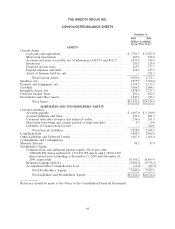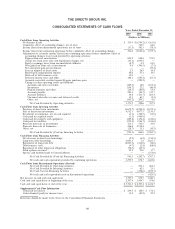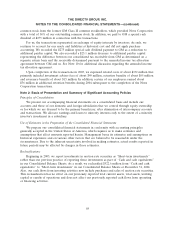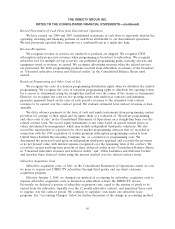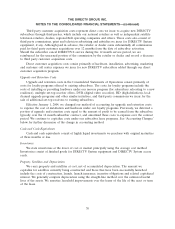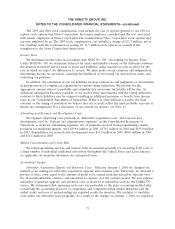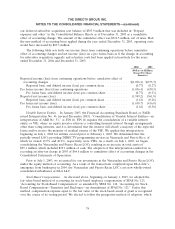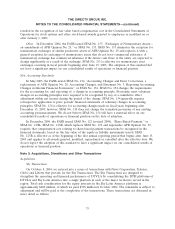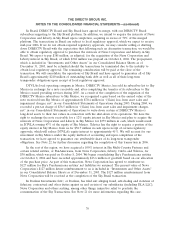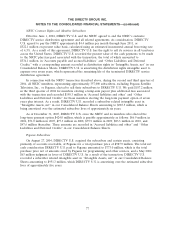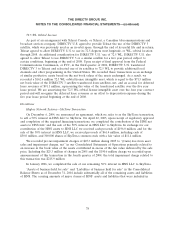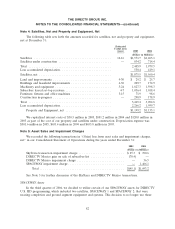DIRECTV 2005 Annual Report Download - page 86
Download and view the complete annual report
Please find page 86 of the 2005 DIRECTV annual report below. You can navigate through the pages in the report by either clicking on the pages listed below, or by using the keyword search tool below to find specific information within the annual report.THE DIRECTV GROUP, INC.
NOTES TO THE CONSOLIDATED FINANCIAL STATEMENTS —(continued)
The 2005 and 2004 stock compensation costs include the cost of options granted to our CEO to
replace stock options that News Corporation, his former employer, cancelled and the cost associated
with former employees of News Corporation who retained their News Corporation stock options and
are now employed by us. The 2003 stock compensation cost includes a charge of $15.2 million, net of
tax, resulting from the acceleration of vesting for 11.5 million stock options as a result of the
completion of the News Corporation transactions.
Income Taxes
We determine income taxes in accordance with SFAS No. 109, ‘‘Accounting for Income Taxes.’’
Under SFAS No. 109, we determine deferred tax assets and liabilities based on the difference between
the financial statement and tax basis of assets and liabilities, using enacted tax rates in effect for the
year in which we expect the differences to reverse. We must make certain estimates and judgments in
determining income tax provisions, assessing the likelihood of recovering our deferred tax assets, and
evaluating tax positions.
In addition, the calculation of our tax liabilities involves evaluations and judgments of uncertainties
in interpretations of complex tax regulations by various taxing authorities. We provide for the
appropriate amount when it is probable and estimable that an income tax liability will be due. As
additional information becomes available, or we resolve these uncertainties with the taxing authorities,
revisions to those liabilities may be required resulting in additional provision or benefit from income
taxes in our Consolidated Statements of Operations. While it is often difficult to predict the final
outcome or the timing of resolution, we believe that our accruals reflect the most probable outcome of
known tax contingencies. For a discussion of our current tax matters, see Note 21.
Advertising and Research and Development Costs
We expense advertising costs primarily in ‘‘Subscriber acquisition costs’’ and research and
development costs in ‘‘General and administrative expenses’’ in the Consolidated Statements of
Operations as incurred. Advertising expenses, net of payments received from programming content
providers for marketing support, were $199.0 million in 2005, $170.1 million in 2004 and $199.0 million
in 2003. Expenditures for research and development were $16.0 million in 2005, $49.0 million in 2004
and $54.6 million in 2003.
Market Concentrations and Credit Risk
We sell programming services and extend credit, in amounts generally not exceeding $100 each, to
a large number of individual residential subscribers throughout the United States and Latin America.
As applicable, we maintain allowances for anticipated losses.
Accounting Changes
Subscriber Acquisition, Upgrade and Retention Costs. Effective January 1, 2004, we changed our
method of accounting for subscriber acquisition, upgrade and retention costs. Previously, we deferred a
portion of these costs, equal to the amount of profit to be earned from the subscriber, typically over
the 12 month subscriber contract, and amortized to expense over the contract period. We now expense
subscriber acquisition, upgrade and retention costs as incurred as subscribers activate the DIRECTV
service. We determined that expensing such costs was preferable to the prior accounting method after
considering the accounting practices of competitors and companies within similar industries and the
added clarity and ease of understanding our reported results for investors. We continue to capitalize
costs under our subscriber lease programs. As a result of the change, on January 1, 2004, we expensed
73



